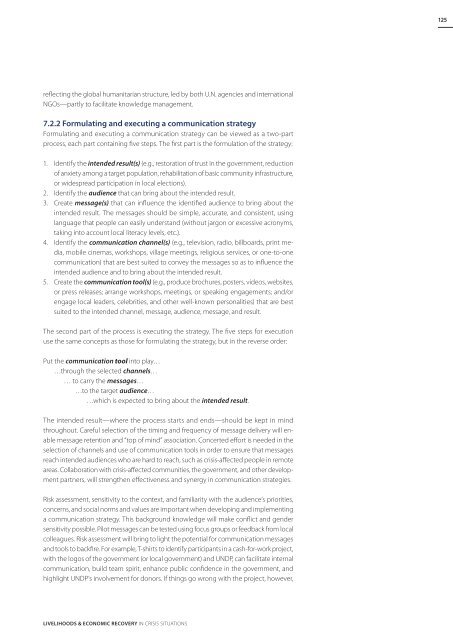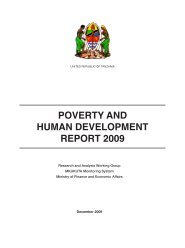Download PDF (4.08 MB) - ReliefWeb
Download PDF (4.08 MB) - ReliefWeb
Download PDF (4.08 MB) - ReliefWeb
You also want an ePaper? Increase the reach of your titles
YUMPU automatically turns print PDFs into web optimized ePapers that Google loves.
125<br />
reflecting the global humanitarian structure, led by both U.N. agencies and international<br />
NGOs—partly to facilitate knowledge management.<br />
7.2.2 Formulating and executing a communication strategy<br />
Formulating and executing a communication strategy can be viewed as a two-part<br />
process, each part containing five steps. The first part is the formulation of the strategy:<br />
1. Identify the intended result(s) (e.g., restoration of trust in the government, reduction<br />
of anxiety among a target population, rehabilitation of basic community infrastructure,<br />
or widespread participation in local elections).<br />
2. Identify the audience that can bring about the intended result.<br />
3. Create message(s) that can influence the identified audience to bring about the<br />
intended result. The messages should be simple, accurate, and consistent, using<br />
language that people can easily understand (without jargon or excessive acronyms,<br />
taking into account local literacy levels, etc.).<br />
4. Identify the communication channel(s) (e.g., television, radio, billboards, print media,<br />
mobile cinemas, workshops, village meetings, religious services, or one-to-one<br />
communication) that are best suited to convey the messages so as to influence the<br />
intended audience and to bring about the intended result.<br />
5. Create the communication tool(s) (e.g., produce brochures, posters, videos, websites,<br />
or press releases; arrange workshops, meetings, or speaking engagements; and/or<br />
engage local leaders, celebrities, and other well-known personalities) that are best<br />
suited to the intended channel, message, audience, message, and result.<br />
The second part of the process is executing the strategy. The five steps for execution<br />
use the same concepts as those for formulating the strategy, but in the reverse order:<br />
Put the communication tool into play…<br />
…through the selected channels…<br />
… to carry the messages…<br />
…to the target audience…<br />
…which is expected to bring about the intended result.<br />
The intended result—where the process starts and ends—should be kept in mind<br />
throughout. Careful selection of the timing and frequency of message delivery will enable<br />
message retention and “top of mind” association. Concerted effort is needed in the<br />
selection of channels and use of communication tools in order to ensure that messages<br />
reach intended audiences who are hard to reach, such as crisis-affected people in remote<br />
areas. Collaboration with crisis-affected communities, the government, and other development<br />
partners, will strengthen effectiveness and synergy in communication strategies.<br />
Risk assessment, sensitivity to the context, and familiarity with the audience’s priorities,<br />
concerns, and social norms and values are important when developing and implementing<br />
a communication strategy. This background knowledge will make conflict and gender<br />
sensitivity possible. Pilot messages can be tested using focus groups or feedback from local<br />
colleagues. Risk assessment will bring to light the potential for communication messages<br />
and tools to backfire. For example, T-shirts to identify participants in a cash-for-work project,<br />
with the logos of the government (or local government) and UNDP, can facilitate internal<br />
communication, build team spirit, enhance public confidence in the government, and<br />
highlight UNDP’s involvement for donors. If things go wrong with the project, however,<br />
Livelihoods & Economic Recovery in Crisis Situations





